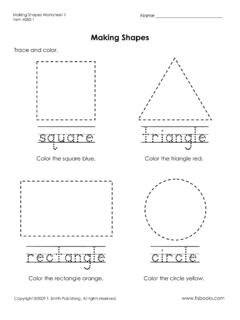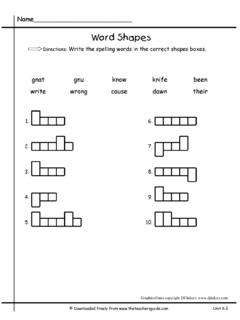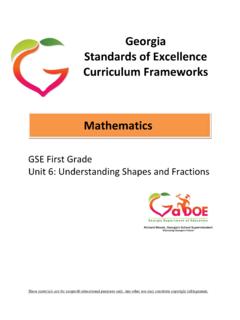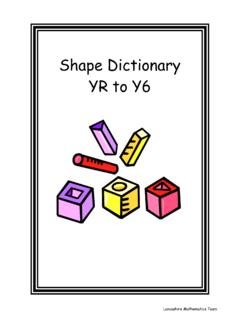Transcription of How to fold simple shapes from A4 paper - Arbelos
1 How to fold simple shapes from A4 February 2012 ContentsIntroduction1 Square2 Equilateral triangle3 Rhombus5 Regular hexagon6 Kite7 Why do the methods work?8 Square ..8 Equilateral triangle ..8 Rhombus ..8 Kite ..8 IntroductionStarting with a single sheet of paper , how do you fold shapes like an equilateral triangle or aregular hexagon? On the following pages instructions are given for folding these and othersimple ability to fold simple shapes quickly provides a ready supply of shapes to handle. This isparticularly useful at the experimental stage of geometry, when the names and properties ofshapes, and the meanings of words like diagonal , are being Andrew Jobbings 2012 SquareThe method is illustrated for A4 paper , but also works for other paper that thecrease passes that thecrease passes completed Andrew Jobbings 2012 Equilateral triangleThe method is illustrated for A4 paper , but also works for other paper in half lengthwise the crease from Step1 so that the new crease the crease fromStep 2 so that the new creasepasses back the flap Andrew Jobbings 2012 The completed is not the largest equilateral triangle that can be folded.
2 Instructions for the maximalequilateral triangle for square paper appear in Robert Gereschl ger s book [1]; for non-squarepaper, the method may still be used just fold the paper into a square Andrew Jobbings 2012 RhombusThe method is illustrated for A4 paper , but also works for other paper in half widthwise the creasefrom Step 1 and the lower creasefrom Step 2 so that the newcrease passes throughM; repeatwithCand the upper the lower creasefrom Step 3 so that the newcrease passes throughB; repeatwithD, the upper crease Andrew Jobbings 2012 The completed smaller angles of the rhombus are 60 . Folding the rhombus in half along the (partial) creasefrom Step 1, produces an equilateral hexagonA regular hexagon may be obtained from the rhombus above by folding the top and bottompoints to the centre along the (partial) creases from Step hexagon obtained in this way is rather small. Instructions for the maximal regular hexagonfor square paper appear in Robert Gereschl ger s book [1]; for non-square paper , the methodmay still be used just fold the paper into a square first.
3 The book also considers the problem offolding maximal regular polygons in Andrew Jobbings 2012 KiteABCDStep1 FoldDontoBCso that thecrease passes =A completed angles of the kite are 45 , 11212 , 90 and 11212 . Andrew Jobbings 2012 Why do the methods work?SquareSince DCXis 45 from Step 1, right-angled triangleCDXhas equal base angles and thereforeCD=DX, as triangleSuperimposing diagrams of the paper before and after the fold in Step 2, and labelling some ofthe points, we obtain the following figure, in whichAXis the crease from Step XNowBB =AB from Step 1, andAB =ABfrom Step 2. ThereforeABB is equilateral and B AB=60 . SinceAXbisects B ABby construction, it follows that all three angles atAare30 and hence one angle of the completed triangle atAis 60 .Finally, the angle of the completed triangle atXis also 60 , because AB X= ABX=90 andwe know that B AX=30 . As a result the completed triangle has two angles of 60 and it istherefore an equilateral method is just that for the equilateral triangle applied twice, once to the bottom half of thepaper, and once to the top method relies on the fact that A4 paper has sides in the ratio 2 : Andrew Jobbings 2012 Consider the left-hand diagram below, which shows the paper after Step 1.
4 It is clear thatABDXis a rectangle. The right-hand diagram also includes the circle circumscribing the rectangle,whose centreOis the midpoint of the diagonals. LetYbe the point where this circle claim thatCDOYis a kite with the required properties. First we shall establish this claim,then show that the remaining folding steps do indeed produce this particular Firstly,DO=OYbecause they are both follows from Step 1 that DCXis 45 . Also BY X=90 sinceBXis a diameter of thecircle. Hence CBY=45 , from the angle sum of triangleBCX. Considering chordDY, wededuce that DOY=2 DBY=90 since the angle at the centre is twice the angle at now use the fact that A4 paper has sides in the ratio 2: 1. LetAB=1, so thatCD= , triangleCBYis a right-angled isosceles triangle (we showed in the last paragraph that itsangles are 45 , 45 and 90 ) andBC= 2. So by Pythagoras theorem we know thatCY= have therefore shown thatCDOYis a kite, with DOY=90 .Next, we know that Step 2 foldsAontoDand so the resulting crease lies alongOY, sinceOisthe midpoint ofADandOYis perpendicular be the position ofXafter the fold in Step 2.
5 ThenX also lies on the circle, withXX perpendicular toOYand therefore parallel toAD. SinceBXis a diameter, BX X=90 , that is,BX is perpendicular toXX and thereforeBX is perpendicular to the diameterAD. It followsthat whenBis folded ontoX then the resulting crease have therefore shown thatCDOYis the shape which results from all the folding steps, Andrew Jobbings 2012 References[1] Robert Geretschl Origami. Arbelos .







